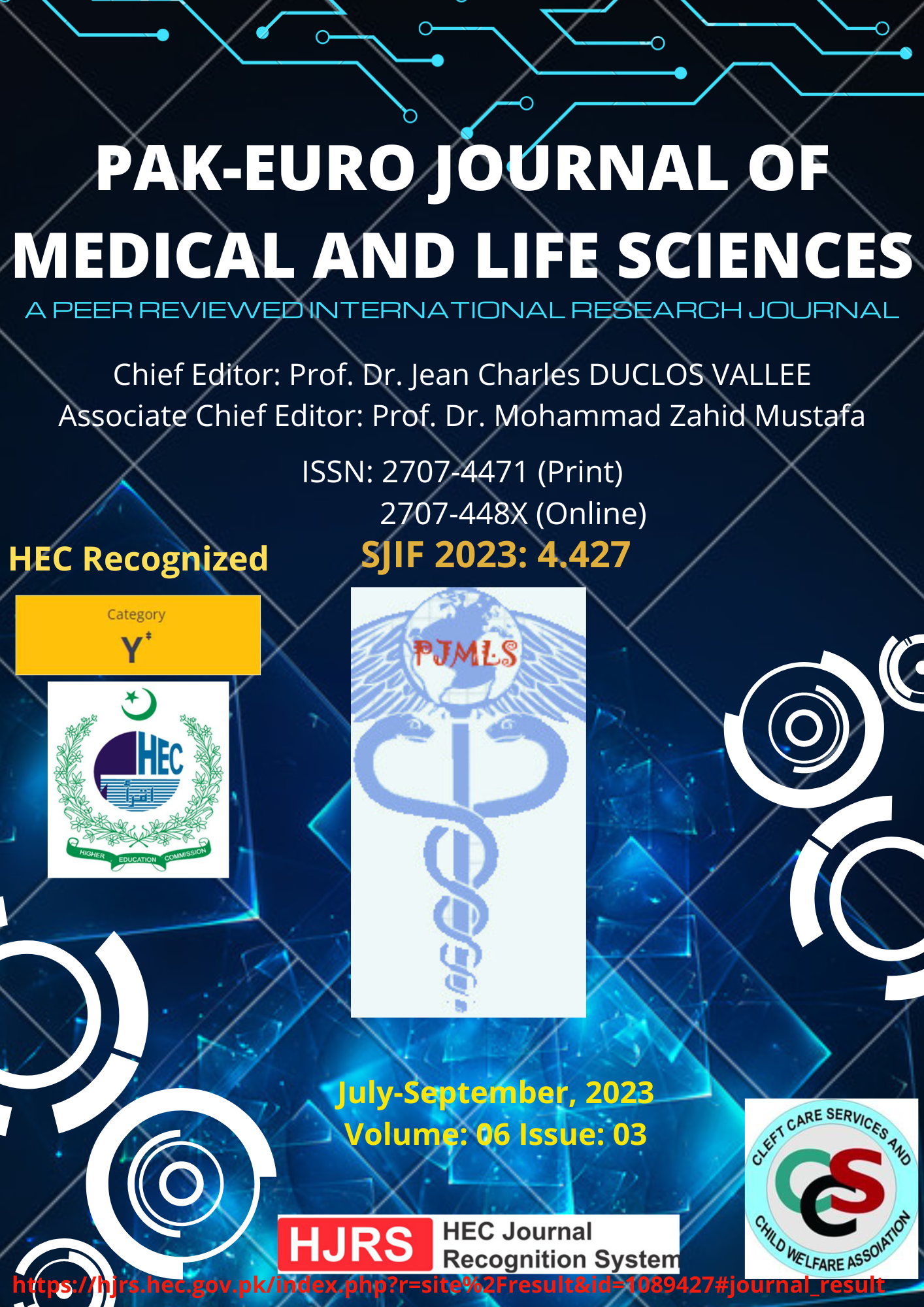A Comprehensive In- Silico Exploration Unveiling Genomic, Structural and Functional Insights
DOI:
https://doi.org/10.31580/pjmls.v6i3.3012Keywords:
Functional implications, Genomic Analysis, IKZF3, Structural Dynamics, Therapeutic Potential, Transcriptional RegulationAbstract
Our study explores the intricate realm of IKZF3, unraveling its genomic, structural, and functional nuances through a comprehensive In-silico analysis. IKZF3, a key transcription factor, plays a pivotal role in diverse biological processes, including immune response and cellular differentiation. Leveraging advanced computational tools, we scrutinized the genomic landscape of IKZF3, identifying key regulatory elements and potential binding sites. Our structural analysis unveiled novel insights into the three-dimensional architecture of IKZF3, shedding light on its conformational dynamics and potential interaction interfaces. Furthermore, we explored the functional implications of IKZF3 in cellular processes, emphasizing its role in modulating gene expression networks. By integrating multi-omics data, we uncovered potential downstream targets and pathways influenced by IKZF3 activity. The findings presented in this study provide a holistic understanding of IKZF3, bridging the gap between genomics and functional biology. This In-silico exploration not only contributes to the growing body of knowledge surrounding IKZF3 but also lays the foundation for future experimental investigations. The insights gained from this study pave the way for targeted experiments to validate the predicted genomic regulatory elements, decipher the functional consequences of IKZF3 interactions, and explore its therapeutic implications in various biological contexts. As we navigate the intricate landscape of transcriptional regulation, this work serves as a valuable roadmap for researchers seeking to unravel the complexities of IKZF3 and its multifaceted roles in cellular physiology.
References
Hosokawa Y, Maeda Y, Takahashi E-i, Suzuki M, Seto M. Human aiolos, an ikaros-related zinc finger DNA binding protein: cDNA cloning, tissue expression pattern, and chromosomal mapping. Genomics. 1999;61(3):326-9.
Hong Y, Wang Q, Song Y-L, Liu G-M, Yang X, Yan M-X. Relationship between IKZF3 Gene Single Nucleotide Polymorphisms and Childhood Acute Lymphoblastic Leukemia. Zhongguo shi yan xue ye xue za zhi. 2021;29(3):690-5.
Burge C, Karlin S. Prediction of complete gene structures in human genomic DNA. Journal of molecular biology. 1997;268(1):78-94.
Punta M, Coggill PC, Eberhardt RY, Mistry J, Tate J, Boursnell C. The Pfam protein families database. Nucleic acids research. 2012;40(D1):D290-D301.
El Yacoubi B, de Crécy-Lagard V. Integrative data-mining tools to link gene and function. Gene Function Analysis. 2014:43-66.
McWilliam H, Li W, Uludag M, Squizzato S, Park YM, Buso N. Analysis tool web services from the EMBL-EBI. Nucleic acids research. 2013;41(W1):W597-W600.
Garg VK, Avashthi H, Tiwari A, Jain PA, Ramkete PW, Kayastha AM. MFPPI–multi FASTA ProtParam interface. Bioinformation. 2016;12(2):74.
Emanuelsson O, Brunak S, Von Heijne G, Nielsen H. Locating proteins in the cell using TargetP, SignalP and related tools. Nature protocols. 2007;2(4):953.
He X, Chang S, Zhang J, Zhao Q, Xiang H, Kusonmano K, et al. MethyCancer: the database of human DNA methylation and cancer. Nucleic acids research. 2007;36(suppl_1):D836-D41.
Julenius K. NetCGlyc 1.0: prediction of mammalian C-mannosylation sites. Glycobiology. 2007;17(8):868-76.
Gupta R, Jung E, Brunak S. Prediction of N-glycosylation sites in human proteins. 2004.
Steentoft C, Vakhrushev SY, Joshi HJ, Kong Y, Vester‐Christensen MB, Schjoldager KTB. Precision mapping of the human O‐GalNAc glycoproteome through SimpleCell technology. The EMBO journal. 2013;32(10):1478-88.
Blom N, Sicheritz‐Pontén T, Gupta R, Gammeltoft S, Brunak S. Prediction of post‐translational glycosylation and phosphorylation of proteins from the amino acid sequence. Proteomics. 2004;4(6):1633-49.
Duckert P, Brunak S, Blom N. Prediction of proprotein convertase cleavage sites. Protein Engineering Design and Selection. 2004;17(1):107-12.
Szklarczyk D, Franceschini A, Kuhn M, Simonovic M, Roth A, Minguez P. The STRING database in 2011: functional interaction networks of proteins, globally integrated and scored. Nucleic acids research. 2010;39(suppl_1):D561-D8.
Olsson L, Johansson B. Ikaros and leukaemia. British journal of haematology. 2015;169(4):479-91.
Li L, Ding X, Wang X, Yao Q, Shao X, An X, et al. Polymorphisms of IKZF3 gene and autoimmune thyroid diseases: associated with Graves’ disease but not with Hashimoto’s thyroiditis. Cellular Physiology and Biochemistry. 2018;45(5):1787-96.
Aggarwal K, Bansal V, Mahmood R, Kanagala SG, Jain R. Asthma and Cardiovascular Diseases: Uncovering Common Ground in Risk Factors and Pathogenesis. Cardiology in Review. 2023:10.1097.
Bairoch A, Apweiler R. The SWISS-PROT protein sequence database and its supplement TrEMBL in 2000. Nucleic acids research. 2000;28(1):45-8.
Hug LA, Baker BJ, Anantharaman K, Brown CT, Probst AJ, Castelle CJ. A new view of the tree of life. Nature microbiology. 2016;1(5):1-6.
Perez-Vilar J, Randell SH, Boucher RC. C-Mannosylation of MUC5AC and MUC5B Cys subdomains. Glycobiology. 2004;14(4):325-37.
Barrett T, Troup DB, Wilhite SE, Ledoux P, Rudnev D, Evangelista C. NCBI GEO: archive for high-throughput functional genomic data. Nucleic acids research. 2009;37(suppl_1):D885-D90.
Jadot M, Boonen M, Thirion J, Wang N, Xing J, Zhao C. Accounting for protein subcellular localization: a compartmental map of the rat liver proteome. Molecular & cellular proteomics. 2017;16(2):194-212.
Downloads
Published
Issue
Section
License
Copyright (c) 2023 Pak-Euro Journal of Medical and Life Sciences

This work is licensed under a Creative Commons Attribution 4.0 International License.






